2012 HONDA CROSSTOUR seats
[x] Cancel search: seatsPage 31 of 435

CONT INUED
Only one airbag will deploy during a
side impact. If the impact is on the
passenger’s side, the passenger’s
side airbag will deploy even if there
is no passenger.
To get the best protection f rom the
side airbags, front seat occupants
should wear their seat belts and sit
upright and well back in their seats.
If you ever have a moderate to
severe side impact, sensors will
detect rapid acceleration and signal
the control unit to instantly inf late
either the driver’s or the passenger’s
side airbag.
Also,makesurethefloormat
behind the f ront passenger’s seat
is properly positioned on the f loor
(see page ). If it is not, the mat
may interfere with the proper
operation of the f ront passenger’s
seat and its sensors.
Back seat passengers should not
wedge objects or intentionally
f orce their f eet under the f ront
passenger seat.
353
Additional Inf ormation About Your Airbags
How Your Side A irbags Work
27
Driver and Passenger Saf ety
2012 Crosstour
Page 33 of 435

The airbag on the passenger’s side
will deploy, even if there are no
passengers on that side of the
vehicle. If the impact is on the passenger’s
side, the passenger’s side curtain
airbag will inflate even if there are no
occupants on that side of the vehicle.
If the rollover sensor detects your
vehicle is about to roll over, it signals
the control unit, which immediately
deploys both side curtain airbags and
activates both f ront seat belt
tensioners.
One or both side curtain airbags may
inflate in a moderate to severe
f rontal collision which causes the
f ront airbags to deploy.
To get the best protection f rom the
side curtain airbags, occupants
should wear their seat belts and sit
upright and well back in their seats.The SRS indicator alerts
you to a potential problem
with your airbag system components.
When you turn the ignition switch to
the ON (II) position, this indicator
comes on brief ly then goes of f . This
tells you the system is working
properly.
If the indicator comes on at any
other time, or does not come on at all,
you should have the system checked
by your dealer. For example:
If the SRS indicator does not come
on after you turn the ignition
switch to the ON (II) position.
If the indicator stays on after the
engine starts.
If the indicator comes on or
flashesonandoff whileyoudrive. If you see any of these indications,
the airbag system components may
not work properly when you need
them.
Additional Inf ormation About Your Airbags
How the SRS Indicator Works
In a Rollover
29
Ignoring the SRS indicator can
result in serious injury or death
if the airbag systems or
tensioners do not work properly.
Have your vehicle checked by a
dealer as soon as possible if
the SRS indicator alerts you to
a possible problem.
Driver and Passenger Saf ety
2012 Crosstour
Page 42 of 435
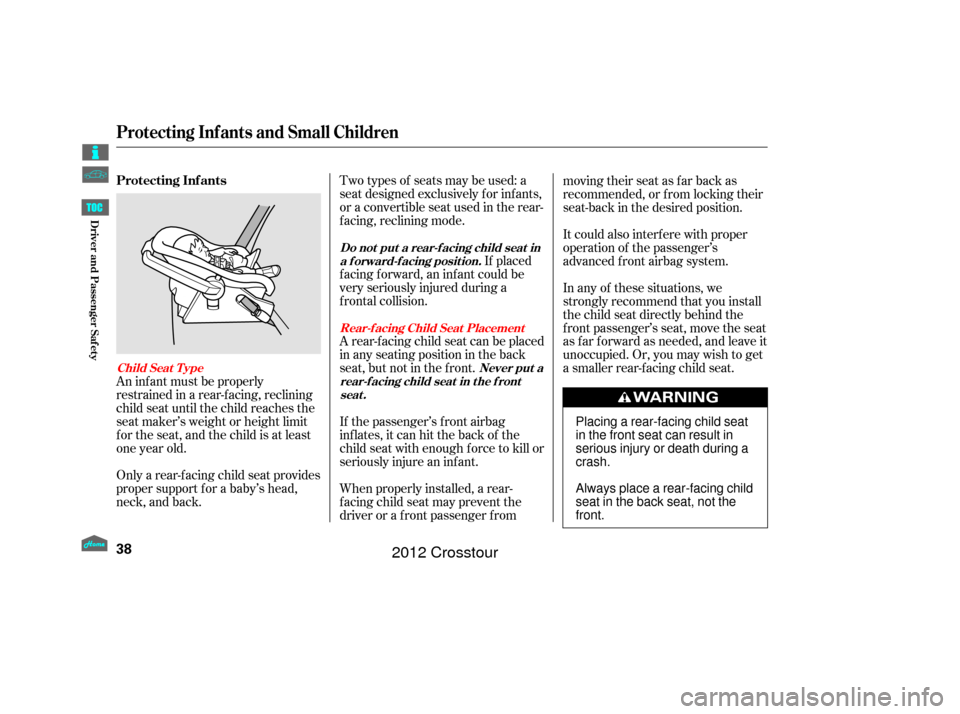
Two types of seats may be used: a
seat designed exclusively f or inf ants,
or a convertible seat used in the rear-
f acing, reclining mode.If placed
f acing f orward, an inf ant could be
very seriously injured during a
f rontal collision.
Only a rear-f acing child seat provides
proper support f or a baby’s head,
neck, and back. An inf ant must be properly
restrained in a rear-f acing, reclining
child seat until the child reaches the
seat maker’s weight or height limit
f or the seat, and the child is at least
one year old. A rear-f acing child seat can be placed
in any seating position in the back
seat, but not in the f ront.
If the passenger’s front airbag
inflates, it can hit the back of the
child seat with enough f orce to kill or
seriously injure an inf ant.
When properly installed, a rear-
f acing child seat may prevent the
driver or a f ront passenger f rommoving their seat as far back as
recommended, or f rom locking their
seat-back in the desired position.
It could also interf ere with proper
operation of the passenger’s
advanced front airbag system.
In any of these situations, we
strongly recommend that you install
the child seat directly behind the
f ront passenger’s seat, move the seat
as far forward as needed, and leave it
unoccupied. Or, you may wish to get
a smaller rear-f acing child seat.
Protecting Inf ants and Small Children
Do not put a rear-f acing child seat in
a f orward-f acing position.
Child Seat T ype Rear-f acing Child Seat Placement
Never put a
rear-f acing child seat in t he f ront seat .
Protecting Inf ants
38
Placing a rear-facing child seat
in the front seat can result in
serious injury or death during a
crash.
Always place a rear-facing child
seat in the back seat, not the
front.
Driver and Passenger Saf ety
2012 Crosstour
Page 43 of 435
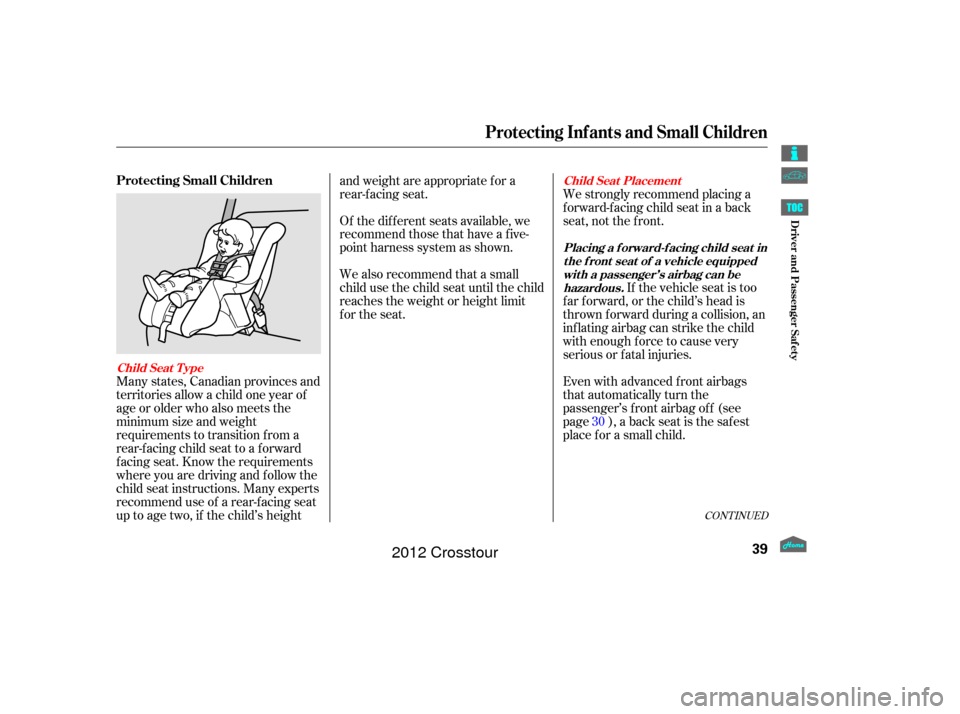
CONT INUED
Many states, Canadian provinces and
territories allow a child one year of
age or older who also meets the
minimum size and weight
requirements to transition f rom a
rear-facing child seat to a forward
f acing seat. Know the requirements
where you are driving and follow the
child seat instructions. Many experts
recommend use of a rear-f acing seat
up to age two, if the child’s heightand weight are appropriate f or a
rear-facing seat.
Of the different seats available, we
recommend those that have a f ive-
point harness system as shown.
We also recommend that a small
child use the child seat until the child
reaches the weight or height limit
for the seat.
We strongly recommend placing a
forward-facing child seat in a back
seat, not the f ront.
If the vehicle seat is too
f ar f orward, or the child’s head is
thrown f orward during a collision, an
inf lating airbag can strike the child
with enough force to cause very
serious or fatal injuries.
Even with advanced front airbags
that automatically turn the
passenger’s front airbag off (see
page ), a back seat is the saf est
place f or a small child. 30
Protecting Inf ants and Small Children
Protecting Small Children
Child Seat T ype Child Seat Placement
Placing a f orward-f acing child seat inthe f ront seat of a vehicle equippedwith a passenger’s airbag can behazardous.
39
Driver and Passenger Saf ety
2012 Crosstour
Page 44 of 435

If it is necessary to put a f orward-
f acing child seat in the f ront, move
the vehicle seat as far to the rear as
possible, and be sure the child seat is
f irmly secured to the vehicle and the
child is properly strapped in the seat.Most child seats are LATCH-
compatible (Lower Anchors and
Tethers f or CHildren). Some have a
rigid-type connector, while others
have a f lexible-type connector. Both
are equally easy to use. Some
existing and previously owned child
seats can only be installed using the
seat belt. Whichever type you
choose, f ollow the child seat
manufacturer’s use and care
instructions as well as the
instructions in this manual. Proper
installation is key to maximizing your
child’s saf ety.In seating positions and vehicles not
equipped with LATCH, a LATCH-
compatible child seat can be installed
using the seat belt and a top tether
f or added security. This is because
all child seats are required to be
designed so that they can be secured
with a lap belt or the lap part of a
lap/shoulder belt.
In addition, the child seat
manufacturer may advise that a seat
belt be used to attach a LATCH-
compatible seat once a child reaches
a specif ied weight. Please read the
child seat owner’s manual f or proper
installation instructions.
Selecting a Child Seat
Protecting Inf ants and Small Children, Selecting a Child Seat
40
Placing a forward-facing child
seat in the front seat can result
in serious injury or death if the
front airbag inflates.
Ifyoumustplaceaforward-
facing child seat in front, move
the vehicle seat as far back as
possible, and properly restrain
the child.
Driver and Passenger Saf ety
2012 Crosstour
Page 45 of 435
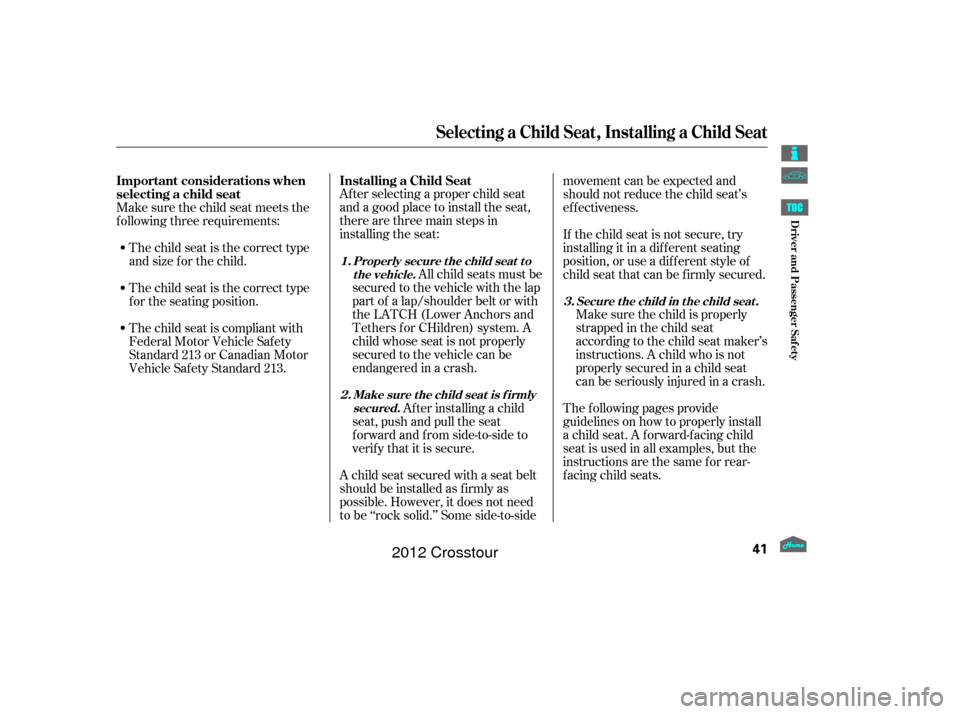
Af ter selecting a proper child seat
and a good place to install the seat,
there are three main steps in
installing the seat:All child seats must be
secured to the vehicle with the lap
part of a lap/shoulder belt or with
the LATCH (Lower Anchors and
Tethers f or CHildren) system. A
child whose seat is not properly
secured to the vehicle can be
endangered in a crash.
Af ter installing a child
seat, push and pull the seat
f orward and f rom side-to-side to
verify that it is secure.
A child seat secured with a seat belt
should be installed as f irmly as
possible. However, it does not need
to be ‘‘rock solid.’’ Some side-to-side movement can be expected and
should not reduce the child seat’s
ef f ectiveness.
If the child seat is not secure, try
installing it in a dif f erent seating
position, or use a dif f erent style of
child seat that can be f irmly secured.
Make sure the child is properly
strappedinthechildseat
according to the child seat maker’s
instructions. A child who is not
properly secured in a child seat
can be seriously injured in a crash.
The f ollowing pages provide
guidelines on how to properly install
a child seat. A f orward-f acing child
seat is used in all examples, but the
instructions are the same f or rear-
f acing child seats.
Make sure the child seat meets the
f ollowing three requirements:
The child seat is the correct type
and size f or the child.
The child seat is the correct type
f or the seating position.
The child seat is compliant with
Federal Motor Vehicle Saf ety
Standard 213 or Canadian Motor
Vehicle Saf ety Standard 213. Installing a Child Seat
Important considerations when
selecting a child seat
Properly secure t he child seat t o
the vehicle.
Make sure t he child seat is f irmlysecured. Secure the child in the child seat.
1.
2. 3.
Selecting a Child Seat, Installing a Child Seat
41
Driver and Passenger Saf ety
2012 Crosstour
Page 46 of 435
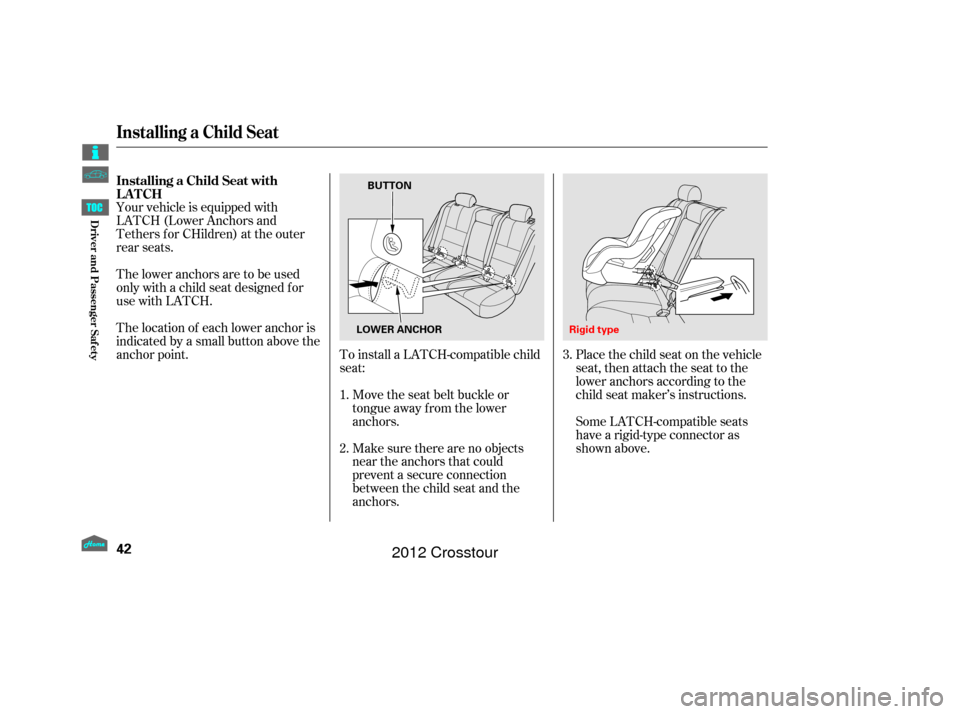
Make sure there are no objects
near the anchors that could
prevent a secure connection
between the child seat and the
anchors. Move the seat belt buckle or
tongue away f rom the lower
anchors.
To install a LATCH-compatible child
seat:
Place the child seat on the vehicle
seat, then attach the seat to the
lower anchors according to the
child seat maker’s instructions.
Your vehicle is equipped with
LATCH (Lower Anchors and
Tethers for CHildren) at the outer
rear seats.
Some LATCH-compatible seats
have a rigid-type connector as
shown above.
The lower anchors are to be used
only with a child seat designed f or
use with LATCH.
The location of each lower anchor is
indicated by a small button above the
anchor point.
1.
2.3.
Installing a Child Seat with
LATCH
Installing a Child Seat
42
BUTTON
LOWER ANCHOR Rigid type
Driver and Passenger Saf ety
2012 Crosstour
Page 47 of 435
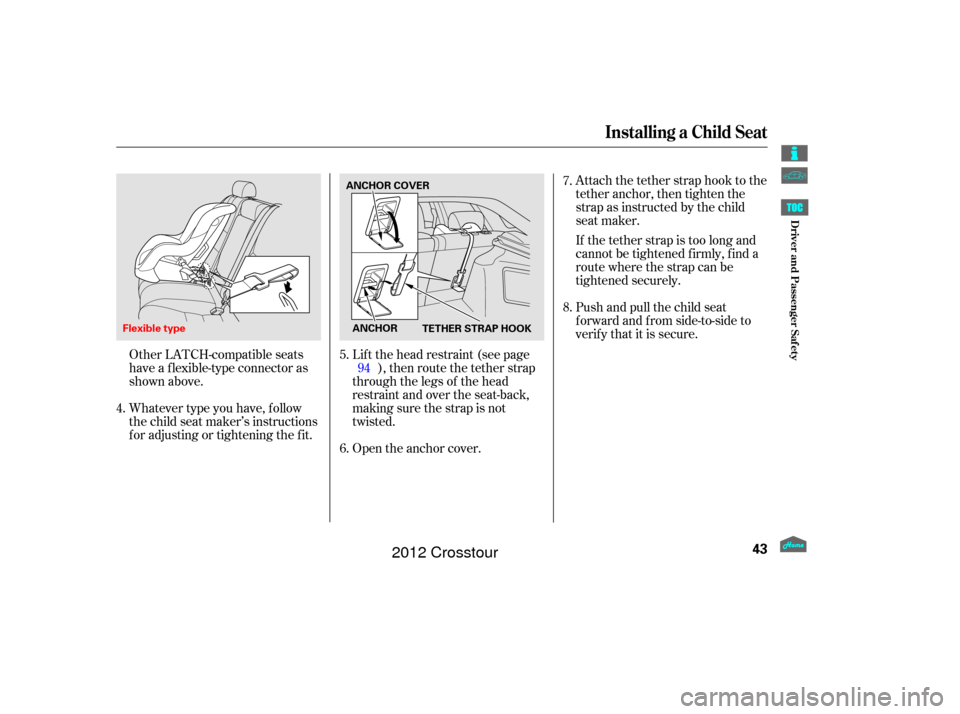
Whatever type you have, f ollow
the child seat maker’s instructions
f or adjusting or tightening the f it. Other LATCH-compatible seats
have a f lexible-type connector as
shown above.Attach the tether strap hook to the
tether anchor, then tighten the
strap as instructed by the child
seat maker.
If the tether strap is too long and
cannot be tightened f irmly, f ind a
route where the strap can be
tightened securely.
Push and pull the child seat
f orward and f rom side-to-side to
verify that it is secure.
Lif t the head restraint (see page ), then route the tether strap
through the legs of the head
restraint and over the seat-back,
making sure the strap is not
twisted.
Open the anchor cover.
4. 5.7.
6. 8.
94
Installing a Child Seat
43
ANCHOR
Flexible type
TETHER STRAP HOOK
ANCHOR COVER
Driver and Passenger Saf ety
2012 Crosstour